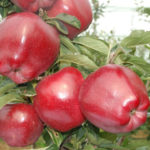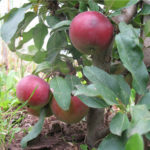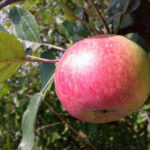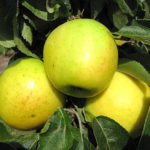Apple variety Iksha (columnar)
There is perhaps no point in arguing that columnar apple trees are a very promising culture. But as is usually the case, the excitement caused by the appearance of the first unusual varieties contributed to the spread in the gardens of Russia of varieties of unknown origin. And few of the gardeners had the knowledge of what a columnar apple tree is, how to grow this curiosity. Because of this, both disappointment and distrust of the new culture appeared. But, as they say, they learn from mistakes. And selection in this direction is developing quite actively and productively, which, of course, makes it possible to rehabilitate slender plants in the eyes of gardeners. So, for example, created by V.V. The Kichina variety Iksha is recognized as one of the most winter-hardy, which makes it possible for the gardeners of the Urals to grow graceful and compact trees in an unfavorable climate. This persistent variety appeared in the Federal State Budgetary Scientific Institution All-Russian Institute of Selection and Technology for Horticulture and Nursery (VSTISP). In 1985, they crossed the colon-shaped donor KV 102 with the winter-hardy variety Lingonberry... In 1990, a seedling was selected, which was initially assigned the number 330/62. Iksha entered breeding in 1996. Our heroine has not yet been entered into the State Register of Breeding Achievements of the Russian Federation, but is actively grown in most of Russia, including in the Moscow Region, Altai Territory and the Urals.
Description
Iksha trees are medium-sized, small-sized, easy to care for due to their compactness. The height of an adult apple tree is usually 2.0 - 2.2 m, and does not exceed 2.5 m. The trunk is strong, the shoots are thick, shortened, attached to the stem at an acute angle. Average leafiness. The leaves are green, large, elongated, with a slightly shiny surface, the apex is slightly pointed, the base is rounded-wedge-shaped, the edges are broad-wavy, serrate-serrated. The petiole is uncolored, of medium length, thick. At a young age, the culture tends to give premature lateral shoots on a one-year growth. The bulk of the crop is formed on ringlets, with which the apple tree is generously covered. Thanks to this, the slender column is densely covered with bright fruits, and therefore looks fabulously beautiful.
Fruits are flat-round, medium-sized funnel, not wide saucer, medium-sized calyx, often closed, sometimes half-open. The skin is thin, but firm and firm, shiny. The main color is yellow. The integumentary appears as a red-striped blush over most of the fruit. In the period of full ripeness, the apples look attractive due to the catchy orange-red-striped color. The pulp is pleasant light cream or honey color, fine-grained consistency, dense, tender and very juicy, saffron aroma, pronounced. The taste is very good, dessert, sweet and sour. Some gardeners compare this taste with Moscow pear tree... Tasters rate the palatability at 4.5 points. The apples are of medium size, their weight is from 80 to 140 g, the maximum weight is about 180 g.
Characteristics
- The early maturity of the compact Iksha is high, it is not for nothing that one of the valuable qualities of columnar crops is a quick entry into the fruiting period. The very next year, after planting a one-year-old seedling, our heroine begins to bring a crop;
- the apple tree has good flowering power, which is estimated at an average of 3.0 points. This indicator directly depends on the degree of freezing of the plant in an unfavorable winter period;
- the first attempt to bring a harvest, which may occur as early as next year, cannot be called successful, there will be few fruits. But from the third year after planting, productivity will increase. From one tree it will be possible to remove already 5.0 - 6.0 kg of orange juicy apples. With proper agricultural technology, the yield can almost double. Some sources voice the figure of 20.0 kg per tree.In industrial plantings, the yield will be 80 - 100 t / ha;
- such high productivity is possible due to the stable and annual yield that the crop is capable of showing for 15 years. After which it is advisable to replace the plant with a new one;
- the harvest ripens in mid-August or early September, depending on the region of planting. Therefore, the variety is referred to as late summer, or early autumn varieties;
- excellent winter hardiness is one of the main distinguishing features of our heroine. It is stated that the plant can withstand frosts down to minus 42 ° C, which is above the level of the well-known Antonovka... Thanks to this characteristic, the variety develops well and bears fruit in the regions located north of Moscow. But at the same time, there is information that in the most unfavorable winter of 2009 - 2010 at the Kaluga state variety section, the total degree of freezing was from 1.0 to 1.5 points. According to experienced gardeners of the Altai Territory and the Urals, statements about high winter hardiness often mislead people who have just begun to master the basics of gardening. By purchasing Iksha, they hope for its endurance, and they grow an apple tree in its usual open form, which is why the top and shoots of the tree often freeze. Therefore, even such a winter-hardy variety is desirable to grow in stanza form;
- immunity is quite high. Even in difficult conditions, where apple trees often suffer from scab, our heroine actively resists this, and other diseases characteristic of the culture as a whole. Therefore, its resistance to diseases and pests is assessed at the level of the best varieties;
- good indicators of adaptability to unpredictable weather conditions increase the reliability of our heroine;
- transportability is average. The data differ on the longevity. Some sources claim that the crop can be stored for about a month without losing its presentation and taste. According to other sources, the fruits can withstand storage for 3 months;
- the way of using the crop is universal. Delicious and healthy apples are recommended to be consumed in their natural form. But so that the rest of the crop is not lost, it can be processed by preparing jam, preserves, jam, compote, marmalade, baking stuffing for consumption in winter. Due to the high content of sugars in the pulp, you can save on this sweet product during the preparation of blanks.
Planting and leaving
Considering that the regions of cultivation can be called not very favorable for culture, the planting of the columnar Iksha apple tree should be done in the spring. The variety loves the sun, so the site must be well lit. In the summer, it will be appropriate to lightly blow the crown with a breeze, but in winter the plant should be protected from the prevailing wind at this time. As a stock, MM 106 and similar ones are most suitable. To prevent annual growths from overgrowing with summer premature shoots, which do not have time to lignify by winter, nitrogen-containing fertilizers should not be abused. In the second half of the growing season, it is more expedient to use phosphorus-potassium fertilizers, which increase the level of winter hardiness. In cooler regions, in addition to the stlate crown, the tree is shaped like a candelabrum, which allows the cultivation of a columnar apple tree in an open form. Watering is carried out as needed, because even in the Urals, the summer period can be both rainy and dry.
And also a small tree can grow in a container and at the same time bear fruit for 10 years. To have such a fabulous plant in a tub, it is necessary to plant Iksha in a 15 - 20 liter container. However, leaving will be different from usual. On hot days, watering can be carried out almost daily, because the substrate in the container dries out very quickly. Top dressing is carried out according to the usual scheme.In order for our heroine to have enough strength to form a crop in the minimum volume of soil, at the stage of ovary formation, rationing will have to be carried out.
The Iksha apple tree is a promising and worthy representative of columnar cultures. Gardeners are attracted by the relative ease of care. The harvested crop can be used in a universal way. In addition, a slender tree will decorate the garden and save a lot of space, because for 1 sq. meter, you can plant several plants. Excellent winter hardiness and resistance to diseases, including scab, makes it possible to cultivate the variety in an unfavorable climate. But at the same time, growing in cool regions will require a slightly different approach than in central Russia, which, however, will not complicate the basic care too much.








